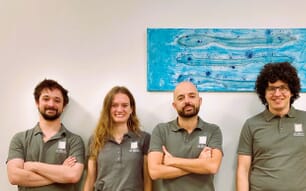To initiate first feeding, Dr Ian Butts (Technical University of Denmark) and fellow scientists gave European eel larvae one of five specially tailored diets. Four of the diets used rotifer paste, of which three included additives (one with cod roe, one with octopus juice, and one with live rotifers). The fifth diet consisted of defrosted plankton collected directly from the Sargasso Sea, where European eels spawn.
Once feeding commenced (after about two weeks), eels on the rotifer paste, rotifer paste with cod roe, and rotifer paste with live rotifers diets showed highest incidence of feeding, and spent much more time swimming then those on the other diets. After about three weeks, the rotifer paste with cod roe, and the rotifer paste with live rotifers seemed to generate the greatest amount of feeding.
Perhaps surprisingly, the larvae given the Sargasso Sea diet never showed any signs of ingesting the plankton.
The scientists also looked at the impact of different light intensities on feeding. In the wild, it is thought that eel larvae make daily ‘vertical migrations’, moving to surface waters at night and down to darker depths in the day. Previous work by the scientists has also demonstrated that, in a captive setting at least, survival for the first 5-days after hatching is vastly improved when the eels are subjected to a 12 hour, low intensity red photoperiod regime.
Light intensity not only impacted incidence of first feeding, but the fullness of the larvae’s guts, with intermediate and high light intensities showing the most favourable outcomes. This may seem counter-intuitive given the vertical migration the larvae are thought to undertake in the wild. The larvae of many marine fish species use a range on senses to find food – including sight.
In well-lit conditions, food is easier to find than in the dark. The easier it is to find food, the fuller the gut of the larvae, the faster it grows, and the more likely it is to survive. In the wild however, marine larvae are also prey to other species. By staying in darker conditions, they are less likely to become dinner to something else. In captivity, they live in the light they are provided with.
With eel aquaculture relying on harvesting wild glass eels for seedlings, full life-cycle aquaculture has been advocated as a way relieve fishing pressure on the wild stock, and captive eel releases as a way to enhance the ever-declining wild stock which is suffering from amongst other things, overfishing and habitat degradation/loss.
Whilst full-lifecycle rearing could contribute towards the sustainability of eel aquaculture, some the benefits to wild stocks has been questioned. For example in another study published earlier this year, Dr Willem Dekker (Swedish University of Agricultural Sciences) and Laurent Beaulaton (Onema, France) note that stock enhancements have been implemented since the 1800’s, with little impact on the overall declining state of the wild eel stock, and significant progress towards solving the other reasons for decline has remained wanting.
The captive rearing of European eel still lags far behind its Japanese counterpart, which has already seen significant advancements in the artificial reproduction of Japanese eels, including successful first-feeding or eel larvae and producing second generation offspring. However, commercially-viable full life-cycle aquaculture is still a challenge, with scientists have difficulty in scaling up production from much smaller experimental conditions.
Back in Europe, Dr Butts and colleagues suggests that the next steps for full life-cycle European eel aquaculture is to look at the dietary needs of the larvae as they continue to develop and transform into ‘glass eels’. Amongst other things, this will require an understanding of the development of the digestive tracts, intestinal enzymatic activity, gene expression, and how larvae absorb nutrients from different diets.




